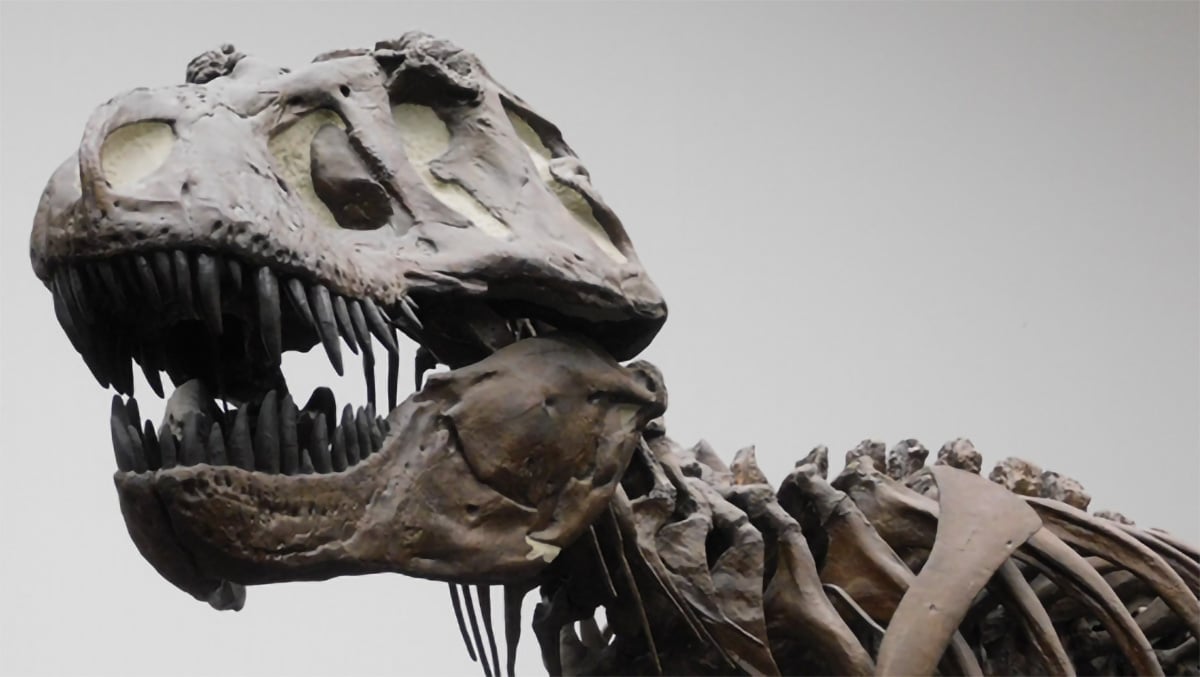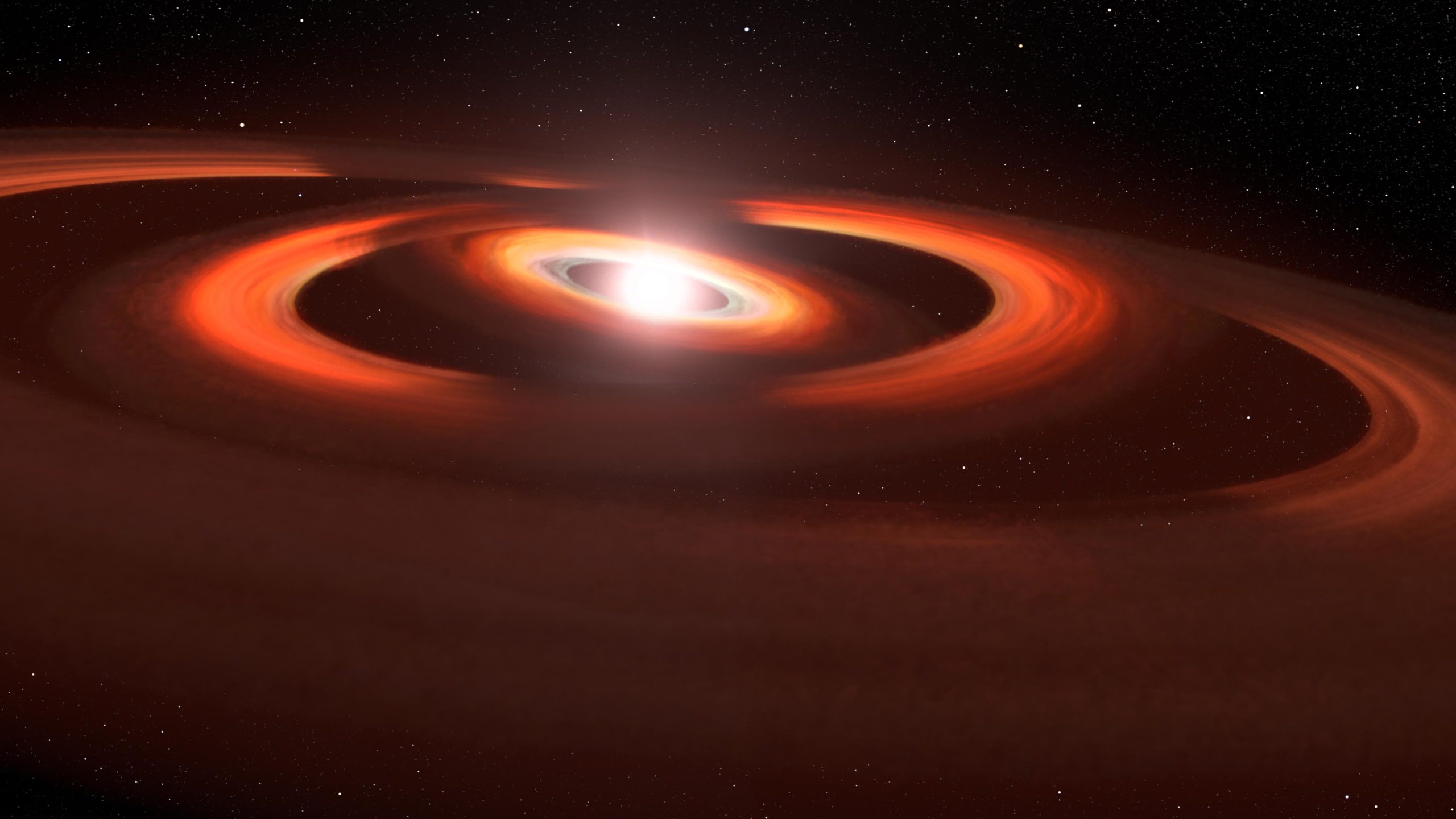Концепция этого художника основана на изображениях газовых и пылевых дисков вокруг молодой звезды TW Hydrae, сделанных космическим телескопом Хаббла. На изображениях космического телескопа Хаббл видны тени, охватывающие диски, окружающие систему. Объяснение состоит в том, что эти тени исходят от слегка наклоненных внутренних дисков, которые препятствуют попаданию звездного света на внешний диск, отбрасывая тень. Диски слегка наклонены друг к другу из-за гравитационной силы невидимых планет, искажающих структуру диска. Авторы и права: НАСА, Aura/STScI, Европейское космическое агентство, Лия Хостэк (STScI)
Невидимые новорожденные планеты поднимают пыль вокруг молодой звезды
Наш мир настолько непостоянен, что иногда любит играть в прятки. В 2017 году астрономы были удивлены, увидев огромную тень, поглощающую диск из пыли и газа, окружающий ближайшую молодую звезду TW Hydrae. Тень отбрасывает внутренний газопылевой диск, слегка наклоненный к плоскости внешнего диска. Тень можно четко увидеть только потому, что система наклонена лицом к лицу на Земле, что дает астрономам возможность увидеть диск с высоты птичьего полета, когда тень мечется по диску, как стрелка, движущаяся по часам.
Но у часов две стрелки (для часов и минут), которые движутся с разной скоростью. И оказывается, что TW Hydrae тоже. Астрономы использовали Хаббл, чтобы найти вторую тень, выходящую из другого внутреннего диска, наклоненную к двум внешним дискам. Таким образом, система кажется все более сложной, по крайней мере, с тремя перекрывающимися дисками, слегка наклоненными друг относительно друга. Диски являются прокси невидимых планет вокруг звезды. Каждая планета своей гравитационной силой притягивает материал рядом со звездой и деформирует то, что было бы идеально плоским диском в форме блина, если бы планет не было. Это неудивительно, ведь у планет в нашей Солнечной системе плоскости орбит отличаются по наклонению на несколько градусов друг от друга. TW Hydrae дает астрономам место у ринга, чтобы увидеть, как могла выглядеть наша Солнечная система в годы ее формирования.

На сравнительных изображениях, сделанных космическим телескопом Хаббла с разницей в несколько лет, видны две жуткие тени, движущиеся против часовой стрелки по диску из газа и пыли, окружающему молодую звезду TW Hydrae. Диски наклонены лицом к лицу на Земле, что дает астрономам возможность увидеть, что происходит вокруг звезды с высоты птичьего полета. На левой фотографии, сделанной в 2016 году, видна только одна тень. [A] Сейчас 11:00. Эта тень отбрасывается внутренним диском, который слегка наклонен к внешнему диску и блокирует звездный свет. На изображении слева показана вторая тень, появившаяся от другого промежуточного диска. [C] 7:00 утра, снято в 2021 году. Оригинальный внутренний диск отмечен [B] в этом последующем шоу. Тени вращаются вокруг звезды с разной скоростью, например, по часовой стрелке. Они свидетельствуют о двух невидимых планетах, которые притянули пыль на свои орбиты. Это заставляет их слегка наклоняться друг к другу. Это изображение в видимом свете, полученное с помощью спектрорадиометра Imaging Spectroradiometer космического телескопа. Для улучшения детализации был добавлен синтетический цвет. Авторы и права: НАСА, ЕКА, STScI, Джон Дебес (AURA/STScI для ЕКА), Джозеф Де Паскуале (STScI)
Космический телескоп Хаббл следит за игрой теней вокруг диска, формирующего планету.
Молодая звезда TW Hydrae играет в «теневых марионеток» с учеными, наблюдающими за ним.[{» attribute=»»>NASA’s Hubble Space Telescope.
In 2017, astronomers reported discovering a shadow sweeping across the face of a vast pancake-shaped gas-and-dust disk surrounding the red dwarf star. The shadow isn’t from a planet, but from an inner disk slightly inclined relative to the much larger outer disk – causing it to cast a shadow. One explanation is that an unseen planet’s gravity is pulling dust and gas into the planet’s inclined orbit.
Now, a second shadow – playing a game of peek-a-boo – has emerged in just a few years between observations stored in Hubble’s MAST archive. This could be from yet another disk nestled inside the system. The two disks are likely evidence of a pair of planets under construction.
TW Hydrae is less than 10 million years old and resides about 200 light-years away. In its infancy, our solar system may have resembled the TW Hydrae system, some 4.6 billion years ago. Because the TW Hydrae system is tilted nearly face-on to our view from Earth, it is an optimum target for getting a bull’s-eye-view of a planetary construction yard.
The second shadow was discovered in observations obtained on June 6, 2021, as part of a multi-year program designed to track the shadows in circumstellar disks. John Debes of AURA/STScI for the European Space Agency at the Space Telescope Science Institute in Baltimore, Maryland, compared the TW Hydrae disk to Hubble observations made several years ago.
“We found out that the shadow had done something completely different,” said Debes, who is principal investigator and lead author of the study published in The Astrophysical Journal. “When I first looked at the data, I thought something had gone wrong with the observation because it wasn’t what I was expecting. I was flummoxed at first, and all my collaborators were like: what is going on? We really had to scratch our heads and it took us a while to actually figure out an explanation.”
The best solution the team came up with is that there are two misaligned disks casting shadows. They were so close to each other in the earlier observation they were missed. Over time they’ve now separated and split into two shadows. “We’ve never really seen this before on a protoplanetary disk. It makes the system much more complex than we originally thought,” he said.
The simplest explanation is that the misaligned disks are likely caused by the gravitational pull of two planets in slightly different orbital planes. Hubble is piecing together a holistic view of the architecture of the system.
The disks may be proxies for planets that are lapping each other as they whirl around the star. It’s sort of like spinning two vinyl phonograph records at slightly different speeds. Sometimes labels will match up but then one gets ahead of the other.
“It does suggest that the two planets have to be fairly close to each other. If one was moving much faster than the other, this would have been noticed in earlier observations. It’s like two race cars that are close to each other, but one slowly overtakes and laps the other,” said Debes.
The suspected planets are located in a region roughly the distance of Jupiter from our Sun. And, the shadows complete one rotation around the star about every 15 years – the orbital period that would be expected at that distance from the star.
Also, these two inner disks are inclined about five to seven degrees relative to the plane of the outer disk. This is comparable to the range of orbital inclinations inside our solar system. “This is right in line with typical solar system style architecture,” said Debes.
The outer disk that the shadows are falling on may extend as far as several times the radius of our solar system’s Kuiper belt. This larger disk has a curious gap at twice Pluto’s average distance from the Sun. This might be evidence for a third planet in the system.
Any inner planets would be difficult to detect because their light would be lost in the glare of the star. Also, dust in the system would dim their reflected light. ESA’s Gaia space observatory may be able to measure a wobble in the star if Jupiter-mass planets are tugging on it, but this would take years given the long orbital periods.
The TW Hydrae data are from Hubble’s Space Telescope Imaging Spectrograph. The James Webb Space Telescope’s infrared vision may also be able to show the shadows in more detail.
Reference: “The Surprising Evolution of the Shadow on the TW Hya Disk” by John Debes, Rebecca Nealon, Richard Alexander, Alycia J. Weinberger, Schuyler Grace Wolff, Dean Hines, Joel Kastner, Hannah Jang-Condell, Christophe Pinte, Peter Plavchan and Laurent Pueyo, 4 May 2023, The Astrophysical Journal.
DOI: 10.3847/1538-4357/acbdf1
The Hubble Space Telescope is a project of international cooperation between NASA and ESA. NASA’s Goddard Space Flight Center in Greenbelt, Maryland, manages the telescope. The Space Telescope Science Institute (STScI) in Baltimore conducts Hubble science operations. STScI is operated for NASA by the Association of Universities for Research in Astronomy, in Washington, D.C.

«Наркоман поп-культуры. Поклонник телевидения. Ниндзя алкоголика. Абсолютный фанат пива. Профессиональный знаток твиттера».





More Stories
Новое исследование показывает, что динозавры были не такими умными, как мы думали
Новая обсерватория в Чили — самая высокая в мире — призвана раскрыть происхождение планет, галактик и многого другого.
Рентгеновский телескоп Einstein Probe опубликовал первые изображения, полученные с помощью «зрения омара»